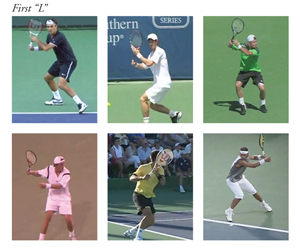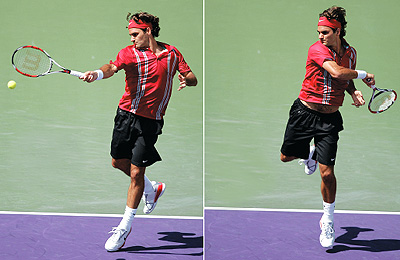The modern forehand technique is responsible for today’s fast paced game of new tennis players that hit the tennis ball harder than ever before.
The changes in the modern tennis forehand technique is the primary reason for the dramatic increase of power and topspin used by today’s top tennis players.
Advancement of the Modern Tennis Forehand
Much has been said and written about the evolution of tennis. The classic game has frequently been compared to the modern game.
The main change is the switch from wooden rackets to graphite rackets. Specific to this change has been the evolution of larger head sizes as well as lighter weights.
Another significant change as a result of advancements in racket technology is the shift in the kind of strings being used. From natural gut, many of today’s players now use a hybrid of natural gut and polyester strings. There are even some players who use polyester strings exclusively.
While the rules of the game have not changed since the sport was institutionalized, the predominant type of court surface used on tour has definitely changed. Before the mid 1970’s, three of the four grand slam events were played on grass.
Today, two of the four are played on hard courts. This is now the predominant surface. In general, surfaces have also been slowed down, especially in the new millennium. There are only about 4 weeks of grass court tennis in a whole year and even these courts have been slowed down. Also, there are hardly any indoor events played on carpet or supreme surfaces.
Professional Players Today in the Modern Forehand
Athletes today are also emphasizing fitness and speed more than ever. Hard scrambling baseline rallies are commonly played by the top players, who all now seem to be able to go from defence to offense with just one shot. Their ability to hit clean winners from the baseline has made volleying at the net much more difficult, hence the demise of the pure serve and volley player.
The result of all these changes in the tennis landscape is the development of the modern game, which, briefly described, is an aggressive baseline game featuring all out power hitting with heavy topspin.
The Modern Tennis Forehand is the New Cornerstone of Tennis
The bread and butter shot for most players remains to be the forehand. Increasingly, though, players are now becoming equally strong, if not stronger, from the backhand. The modern forehand is one shot that has seen a number of changes compared to the classic version played during the earlier years.


Modern Forehand Technique: The Modern forehand today is based on a rotational element, rather than a traditional straight back linear forehand backswing of the past
The modern forehand is now the main point-ending shot for most players. This shot is a lot more powerful and has a lot more topspin than the classic forehand, which was usually flatter. Certainly, on fast surfaces, more relatively flat forehands used to be hit.
Today, a player like Rafael Nadal, who hits with the most amount of topspin on his forehand, has been able to win Wimbledon twice and make the final on three other occasions. On clay courts, there were already a lot of topspin forehands but they were a lot slower than they are today.
Bjorn Borg’s Evolution of the Modern Forehand
The technique of the modern forehand is thought to have started out with the great Swedish player Bjorn Borg. Although he still played with wooden rackets, he used a more western grip and put a lot of topspin on the ball. He met the ball with a slightly bent arm and a laid back wrist. He hit through the ball, producing power as well as topspin. And lastly, he had a longer follow-through that ended up with the racket head wrapping past the left shoulder.
Borg used natural gut strings as everyone else did during his time, but he strung his rackets with an unheard of tension of 80 lbs/in2. For him, this provided control even when he was swinging as hard as he could and generating very fast racket head speeds.
Today’s players use polyester strings which are stiffer, more durable and less elastic than natural gut. This probably simulates the playing characteristics of tightly strung natural gut, without being too easily broken. However, because the physical properties of polyester and natural gut are different, some players have discovered that stringing polyester at very low tensions (i.e. 25-35 lbs) can be equally beneficial for playing the modern game.
Implementing Different Styles of Backswings on the Modern Forehand
The truth is that whether you talk about the classic forehand or the modern forehand, each player has a different way of hitting the ball. Players who grew up on hard courts usually hit their forehands flatter than those who grew up training predominantly on clay. In the past, when grass was a more widespread surface, there was a bigger difference among the various ways that players hit their forehands. In general, what is usually designated as the classic forehand is the flat, eastern grip forehand.
Continental Forehand Grip: A classic forehand
The continental forehand is also considered classic. This stroking style makes use of the closed stance. The racket was taken straight back or only with a slight loop with body weight being loaded on the back foot.
The forward swing was fast and flat through the ball as the weight was transferred to the front foot which was used as a pivot for the stroke. At contact, the arm was either straight or only slightly bent at the elbow. The wrist was somewhat laid back. The follow through was straight forward in the direction of the ball and rarely finished over the opposite shoulder.


Tennis Stance: The modern tennis forehand is most often hit with either a open/semi-open or neutral stance. Today, the most commonly used stance is the: open stance, semi-open stance and neutral stance
The Classic Old School Forehand
Semi-western and western grip forehands existed in the classic era, but were rare. The mechanics were generally the same as the eastern forehand, except that after the backswing, the player dropped the racket head lower than the path of the incoming ball. At contact, the player brushed up the back of the ball and through it.
The follow through was forward in the direction of the ball but more steeply upward. As a precursor to the modern forehand, the racket head could also finish over the opposite shoulder. The main difference is that the shot produced, while having topspin, wasn’t a fast shot compared to the modern forehand.
While almost all classic forehands were hit with a closed stance, today’s forehand can be hit from any stance as long as there is proper balance and weight transfer. The grip can be eastern, semi-western or western but never continental, unless the player wants to slice. The continental grip is never used to hit flat shots anymore. Most of the time, the racket is held with a variation of the semi-western or western grip.
Modern Tennis Forehand Mechanics
The take back of the modern forehand is more looped or circular in order to generate greater racket head speed. The elbow is relaxed or bent and may remain so throughout the stroke, although some players straighten out their arm at contact. The wrist is laid back. The hips and shoulders turn completely and the weight is loaded on the back foot. The forward swing sees the hips and shoulders uncoil as the racket head drops down below the level of the ball. At contact, the torso usually faces the net.


Rafael Nadal’s Forehand: A world class forehand utilizing modern tennis forehand technique with a fluid backswing and an aggressive low to high swinging pattern
The racket hits the ball squarely behind while going through it and lifting it up for topspin. Advancements in racket and string technology allow the ball to linger on the string bed a fraction of a second longer than before, allowing more topspin to be created by the upward motion of the racket head.
Torso Rotation in the Modern Forehand
The torso continues to rotate as the weight is transferred from back foot to front foot, frequently setting the player airborne. The follow through is long and may finish in one of four ways:
- As a quick whip steeply upward ending over the shoulder of the hitting arm. This is called the reverse forehand and is used when on the run, to create angles or to catch up to the ball when the player is late on his or her stroke.
- As a variation of the first follow through but with the racket finishing over the head in a lassoing motion as typically used by Rafael Nadal.
- Over the opposite shoulder, as is usually recommended by coaches.
- Past the opposite shoulder to the side of the body – the so-called windshield wiper follow through, which Roger Federer uses.All in all, the modern forehand is the shot that wins the most points for most players. Aside from the recent dominance of players like Nadal and Federer, the new top player Novak Djokovic and the latest grand slam women’s champions Petra Kvitova and Li Na have been able to break through by improving their forehands. It is the shot that any competitive player must master in order to get to the top of the sport.
Learn to Hit a Forehand Like Roger Federer
If you want to jumpstart your forehand and play like the PROS, check out my 70+ page Tennis Ebook that will immediately show you how you can take your forehand to the next level.
The Modern Forehand Domination Ebook is guaranteed to improve your tennis technique, and increase power, topspin and accuracy of your tennis forehand!
Modern Tennis Forehand Ebook
Learn How to Hit a Forehand Like Federer, Nadal and Djokovic

